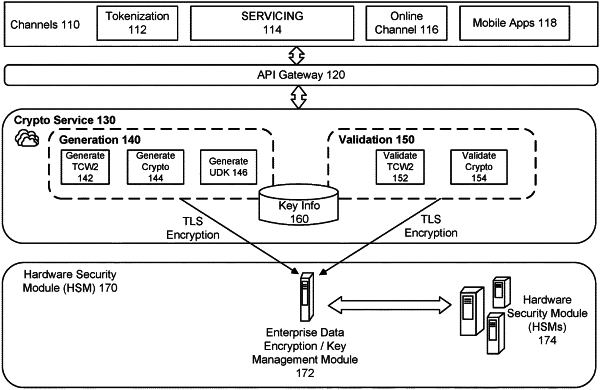| CPC G06Q 20/4018 (2013.01) | 20 Claims |

|
1. A system that generates a temporal card verification value (CVV2) for secure transaction processing, the system comprising:
a server that receives data from one or more customer channels, the customer channels comprising a tokenization channel, a servicing channel, an online channel, and a mobile apps channel; and
a crypto system that comprises a computer processor, coupled to the server, the computer processor performs each of:
in response to approving a customer for a new physical card that is not connected to an existing account and providing a card number and expiration date for the new physical card to the customer, receiving a request from the customer for a Temporal CVV2 to initiate a transaction with the card number and expiration date, wherein the card number is associated with a new account that is newly created for the new physical card,
wherein a risk level is associated with the transaction;
in response to determining that the new physical card has not yet been received or activated by the customer, generating, via a crypto generation processor, a unique Temporal CVV2 that is distinct from a CVV2 that is printed on the card and associated with the card number;
applying a counter for the unique Temporal CVV2, wherein the counter is recalculated when a request for a new Temporal CVV2 is received,
wherein the Temporal CVV2 comprises a validity parameter,
wherein the Temporal CVV2 adds one or more parameters based on the risk level, and
wherein the Temporal CVV2 includes one or more restrictions, the one or more restrictions comprising a valid time period and a time limit as well as one or more valid transaction types and one or more approved merchants;
validating, via a crypto validation processor, the Temporal CVV2 to process the transaction, the validation including a determination that the CVV2 meets the one or more restrictions;
communicating, via a secure encryption protocol, the Temporal CVV2 to one or more hardware security servers;
in response to determining that the new physical card has been received or activated by the customer, automatically terminating the unique Temporal CVV2; and
when the new physical card expires, reissuing another unique Temporal CVV2,
wherein the unique Temporal CVV2 is crypto encrypted,
wherein the unique Temporal CVV2 has a maximum number of usage greater than 1, and
wherein both the unique Temporal CVV2 and the CVV2 that is printed on the physical card share same card number and expiration date.
|